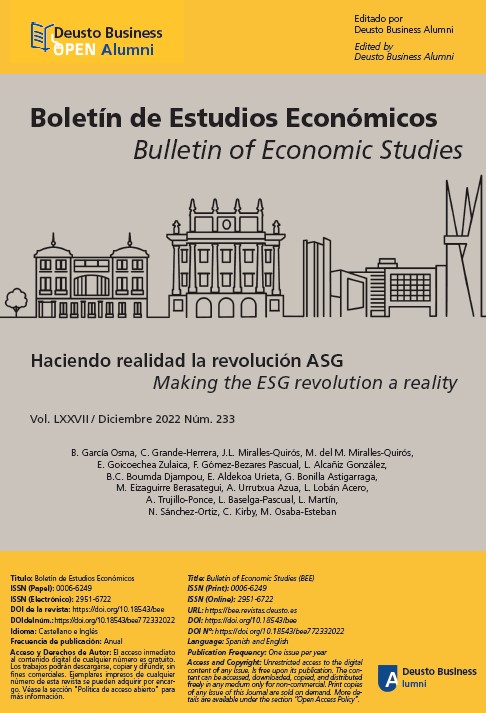Cadenas de suministro antifrágiles: un nuevo paradigma en la gestión de inventarios
Resumen
En el año 2012, Taleb planteó un innovador concepto, la ‘antifragilidad’, que es una capacidad potencialmente desarrollable por personas, sistemas, organizaciones. También por cadenas de suministro. La sub-disciplina de Gestión de Riesgos de la Cadena de Suministro (SCRM-Supply Chain Risk Management) está empezando a adoptar este nuevo enfoque, tan necesario en la actualidad, tanto por las características del contexto como por las prácticas empresariales más extendidas en la gestión de la cadena de suministro de los últimos 30 años. Este artículo presenta este concepto y sus implicaciones de gestión, junto con aplicaciones específicas en la gestión de inventarios.
Recibido: 20 noviembre 2022
Aceptado: 22 noviembre 2022
Citas
Adobor, H. (2020). Supply chain resilience: An adaptive cycle approach. The International Journal of Logistics Management, 31(3), 443-463. DOI: https://doi.org/10.1108/IJLM-01-2020-0019
Alicke, K., Barribal, E. & Trautwein, V. (2021). How COVID-19 is reshaping supply chains. Retrieved from http://bit.ly/3AXsvqj
APICS. (2008). APICS dictionary (12th ed.). Chicago, Ill: APICS.
APICS. (2019). APICS dictionary: The essential supply chain reference (16th ed.) APICS. Retrieved from http://cds.cern.ch/record/1992292
Brynjolfsson, E., Hu, Y., & Simester, D. (2011). Goodbye pareto principle, hello long tail: The effect of search costs on the concentration of product sales. Management Science, 57(8), 1373-1386. DOI: https://doi.org/10.1287/mnsc.1110.1371
Carpenter, S., Walker, B., Anderies, J.M., & Abel, N. (2001). From metaphor to measurement: Resilience of what to what? Ecosystems, 4(8), 765-781. DOI: https://doi.org/10.1007/s10021-001-0045-9
Christopher, M., & Peck, H. (2004). Building the resilient supply chain. The International Journal of Logistics Management, 15(2), 1-14. DOI: https://doi.org/10.1108/09574090410700275
Feitzinger, E., & Lee, H.L. (1997). Mass customization at Hewlett Packard: The power of postponement. Harvard Business Review, 75, 116-123.
Goldsby, T.J., Griffis, S.E., & Roath, A.S. (2006). Modeling lean, agile, and leagile supply chain strategies. Journal of Business Logistics, 27(1), 57-80. DOI: https://doi.org/10.1002/j.2158-1592.2006.tb00241.x
Ivanov, D. (2020). Viable supply chain model: Integrating agility, resilience and sustainability perspectives—lessons from and thinking beyond the COVID-19 pandemic. Annals of Operations Research, 1-21. DOI: https://doi.org/10.1007/s10479-020-03640-6
Ivanov, D., Sokolov, B., & Dolgui, A. (2013). The ripple effect in supply chains: Trade-off ‘efficiency-flexibility-resilience’ in disruption management. International Journal of Production Research, 52(7), 2154-2172. DOI: https://doi.org/10.1080/00207543.2013.858836
Jüttner, U. (2005). Supply chain risk management. The International Journal of Logistics Management, 16(1), 120-141. DOI: https://doi.org/10.1108/09574090510617385
Lee, H. L., Padmanabhan, V., & Whang, S. (1997). Information distortion in a supply chain: The bullwhip effect. Management Science, 43(4), 546-558. DOI: https://doi.org/10.1287/mnsc.43.4.546
Martin, C., & Towill, D.R. (2000). Supply chain migration from lean and functional to agile and customised. Supply Chain Management, 5(4), 206-213. DOI: https://doi.org/10.1108/13598540010347334
Nguyen, A., Lamouri, S., Pellerin, R., Tamayo, S., & Lekens, B. (2021). Data analytics in pharmaceutical supply chains: State of the art, opportunities, and challenges. onal Journal of Production Research, 1-20. DOI: https://doi.org/10.1080/00207543.2021.1950937
Nikookar, E., Varsei, M., & Wieland, A. (2021). Gaining from disorder: Making the case for antifragility in purchasing and supply chain management. Journal of Purchasing and Supply Management, 27(3), 100699. DOI: https://doi.org/10.1016/j.pursup.2021.100699
Noblitt, J.M. (2001). EOQ. panacea or plague? APICS–The Performance Advantage, 53-57.
Sako, M. (2022). Global supply chain disruption and resilience. Communications of the ACM, 65(4), 18-21. DOI:10.1145/3517216
Shashi, Centobelli, Cerchione, & Ertz. (2020). Managing supply chain resilience to pursue business and environmental strategies. Business Strategy and the Environment, 29(3), 1215-1246. DOI: https://doi.org/10.1002/bse.2428
Sheffi, Y. (2022). Prepare for the bullwhip’s sting. MIT Sloan Management Review, 63(2), 1-5.
Shih, W.C. (2020). Global supply chains in a post-pandemic world: Companies need to make their networks more resilient; here’s how. Harvard Business Review, 98(5), 82.
Slack, N., & Brandon-Jones, A. (2018). Operations and process management (Fifth edition). Harlow, England: Pearson. Srinidhi, B., & Tayi, G.K. (2004). Just in time or just in case? an explanatory model with informational and incentive effects. Journal of Manufacturing Technology Management, 15(7), 567-574. DOI: https://doi.org/10.1108/17410380410555817
Taleb, N.N. (2012). Antifragile (1th Ed.). GB: Penguin Books Ltd. Taleb, N.N. (2007). The black swan. New York: Random House.
Tummala, R., & Schoenherr, T. (2011). Assessing and managing risks using the supply chain risk management process (SCRMP). Supply Chain Management, 16(6), 474-483. DOI: https://doi.org/10.1108/13598541111171165
Wieland, A. (2021). Dancing the supply chain: Toward transformative supply chain management. The Journal of Supply Chain Management, 57(1), 58-73. DOI: https://doi.org/10.1111/jscm.12248
Wilson, J.M. (2018). Deconstructing the reinvention of operations management. Journal of Management History (2006), 24(2), 128-155. DOI: https://doi.org/10.1108/JMH-06-2017-0028
Wilson, R.H. (1934). A scientific routine for stock control. Harvard Business Review, 13, 116.
Licencia:
Los trabajos publicados en esta revista desde 2021 se encuentran disponibles bajo la licencia Creative Commons Attribution-NonCommercial 4.0 International - CC BY-NC 4.0. La actual política de acceso abierto de la revista no se aplica a los contenidos previos 2021.
Derechos de los autores/as:
Los autores y las autoras conservan los derechos de autor/a sobre sus trabajos publicados en el Boletín de Estudios Económicos y conceden a éste derechos no exclusivos para la explotación de los trabajos con fines de maquetación, publicación y difusión. Esta licencia permite al Boletín de Estudios Económicos distribuir, reproducir y difundir los trabajos en su plataforma y otros medios, siempre bajo las condiciones descritas en este aviso.
Derechos de los lectores/as:
Los lectores y las lectoras pueden leer, descargar, imprimir, buscar, compartir (copiar, redistribuir o enlazar textos completos), o adaptar (remezclar, transformar y construir a partir del material) el contenido, siempre que:
- No se utilicen los materiales con fines comerciales.
- Se cite adecuadamente el trabajo original, incluyendo el nombre de la persona autora y la fuente.
- Se indique claramente cualquier modificación realizada al contenido original.
El uso comercial de los materiales está prohibido sin el permiso expreso de las personas autoras. Para mayor claridad, se considera uso comercial cualquier actividad que tenga como fin la obtención de beneficios económicos o que implique un intercambio comercial directo.
Condiciones de uso:
El uso del contenido no debe infringir los derechos de otras personas, ni debe ser utilizado de manera que pueda dañar la reputación del/la autor/a o del Boletín de Estudios Económicos.
Responsabilidad por el contenido:
Los/las autores/as son responsables del contenido de sus trabajos y el Boletín de Estudios Económicos no se hace responsable de las opiniones expresadas en los mismos.
Más información:
Política de Acceso Abierto, Licencia y Derechos de Autor/a


.jpg)
.jpg)
.jpg)







